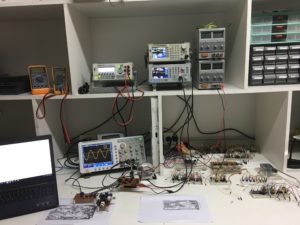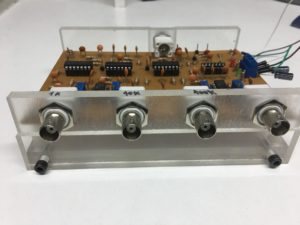IFIMAR Electronics Laboratory
Birth of the Laboratory:
The laboratory of electronic of sea of the silver is born with the intention to help the development of the experimental physics in the institute. IFIMAR being an institute almost completely dedicated to theoretical physics, in 2014 it was decided to start exploring the possibilities of the development of experimental physics through the Institute's Electronic Laboratory, so the Laboratory plays a fundamental role in creating bridges between theoretical physics and experimental physics.
Lab Objective:
The main objective of the institute's electronic laboratory is to bring technology to the world of basic science research in order to combine science and technology and obtain more fruitful and abundant results in the development of physics as a scientific discipline.
Instruments with which the laboratory has:
The laboratory is in full training. However, it has a variety of instruments that allow it to be associated with different research projects. Among the instruments with which the laboratory counts are:
- 1 4-Channel Oscilloscope, 200 Mhz Bandwidth
- 1 2-channel signal generator, with a bandwidth of 25 Mhz
- 2 30V / 5A voltage sources with current and voltage limiters
- 1 Programmable 6 and ½ digit laboratory digital multimeter
- 1 Precision Soldier Station
- 2 portable digital multimeters
- 1 PC Laptop dedicated to virtual instrumentation and data collection of instruments accessible through the PC.
- A varied range of electronic components and supplies necessary for the development of a wide range of analog and digital prototypes
- Instruments developed by the laboratory based on the need of the different projects in which it participates
Own Development Instruments:
It is important to emphasize that there are innumerable situations in which the electronic instruments that are usually commercialized in the market do not always manage to cover all the needs that a project or experiment may require. For this reason, the laboratory has had to develop its own instruments on more than one occasion. Here are the most important:
- Gaussian Noise Generator with 4 + 4 channels. The instrument generates completely independent Gaussian random noise in 4 channels and has another 4 channels where Gaussian noise is obtained as a result of the linear combination of the first 4.
- Variable bandwidth analogue filters based on Sallen Key configuration up to grade 8. When it is necessary to use noise of some kind, filtering it is very important due to the frequency content of this noise so that it can be used within the parameters of the prototype to which it applies.
- Instrument for the real-time measurement of the probability density function of a noise signal. This type of instrument is extremely useful when working with random variables and stochastic processes, since in general, when working with random variables in a system, a random variable is obtained that can be well characterized through its density function. probability.
Featured Jobs:
- Through the laboratory, it was possible to corroborate experimentally certain phenomena related to the confinement of noise, achieving the electronic synthesis of the Langevin equation, which led to a publication in the North American magazine "Physical Review". This article can be found under the name: "Limiting the stroke of a Schmitt trigger with multiplicative noise. Physical Review E .: American Physical Society. 2017 vol.95 n ° 5. p. issn 2470-0045. eissn 2470-0053, authors: Zarza, Gabriel A .; Mangioni, Sergio E .; Acevedo Javier Fernadez; Deza, Roberto R.
- The laboratory is currently working on two new experiments whose results, it is hoped, can also be published in internationally renowned journals.
Training aspects of the Electronics Laboratory: Among the activities developed in the laboratory, the training of resources stand out Humanities of students through scholarships of initiation to the research and thesis of degree and doctorates:
- The laboratory has housed 1 advanced student, a scholarship holder with a scholarship from the National Iinteruniversity Council of initiation to the investigation, carrying out 1 work of 1 year duration on electronic neurons and their implementation using integrated circuits called Schmitt triggers called "Non-trivial effects of noise in non-linear electronic circuits and their applications"
- The experimental part of the 1 thesis entitled "Endomorphic Computing and Space-Temporal Patterns in Electronic Neurons with Inhibitory Synaptic Coupling"
- Currently the laboratory is collaborating in the training of a doctoral student in his second year of doctoral fellowship. This student is working on the doctoral thesis entitled: "Experimental study of avalanches in networks of excitable electronic elements"
Interaction with other entities dependent on CONICET: The electronic laboratory, with the intention of improving and increasing its capabilities, is in constant contact with those responsible for the purchase of equipment for the laboratory through the necessary collaboration for the correct choice of instruments. This collaboration is basically established at the technical level:
- The electronic laboratory has been an active participant in the assembly of folds and called for a tender for the PMI project for the purchase of basic instruments for the electronics laboratory.
- It has also actively participated in the importation of basic electronic and medium complexity inputs that were not possible to acquire locally.
We offer our services to the society for custom projects. For more information contact: Responsible: Professional CPA - Magister Engineer Gabriel Alejandro Zarza
Contact:
mail: gzarza@ifimar-conicet.gob.ar
0054 0223 475-5507 (int 41)

